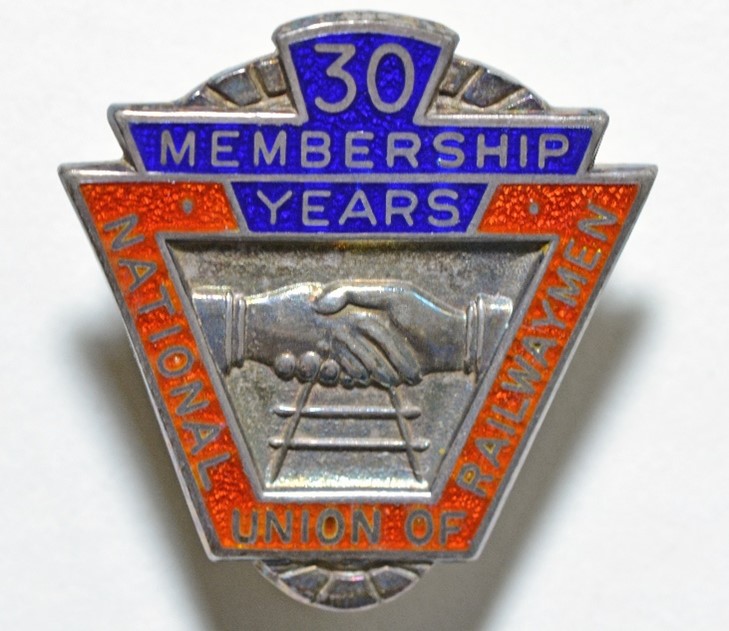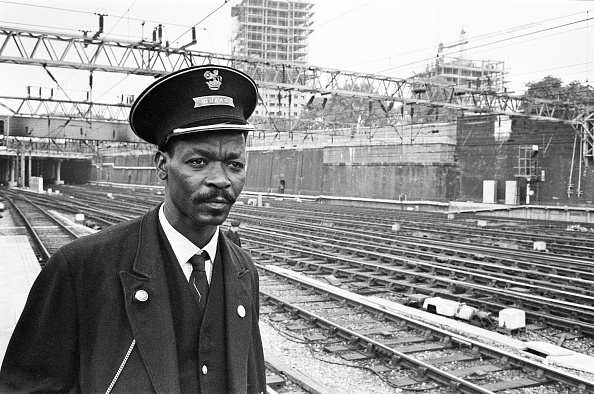In 1966 the eyes of the world were on London. In April TIME magazine heralded it as the place for fashion, music and fun, ‘The Swinging City… steeped in tradition, seized by change, liberated by affluence…’
On 11 July, the football World Cup kicked off at Wembley Stadium and would end there just over a fortnight later with England crowned world champions.
In 1966 Britain’s railways were changing too. In the month that TIME’S ‘Swinging City’ edition hit the newsstands, British Railways (BR) launched its new fast and frequent electric train service between London’s Euston station and Manchester.
A new Euston station was also being constructed, hailed by the press as an ultra-modern symbol of progress.
Whilst the ‘affluence’ of modern London and its buzzing cultural scene may have captured the imagination, the reality for many who lived and worked there was very different.
So too on the railways. Behind the modern façade of the new Euston another, darker story was emerging.
The railway was modernising in parts, but the network was contracting too because of the Beeching cuts which saw many thousands of route miles closed.
In 1966 large sections of the former Great Central Railway route linking Nottingham and Sheffield to London’s Marylebone station were closed leading to redundancies amongst Marylebone’s train guards.
One of those guards applied for a transfer to Euston. However, his application was rejected by the powerful Euston staff representatives committee.
His name was Asquith Xavier and he was rejected because of the colour of his skin. The case of Asquith Xavier would prove a seminal moment that had repercussions beyond Britain’s railways.
Colour bars within British industry provided much controversy in the 1950s and 1960s. In 1950 the Railway Executive denied that a policy ‘against British Colonials’ being employed on the railways existed, but there can be no doubt that localised colour bars were in place.
In 1952, for example, Jim Figgins, General Secretary of the National Union of Railwaymen, and John Shearer, the union’s area representative, intervened in a strike at King’s Cross goods depot following the promotion of Stephen Salmon, a 33 year-old West Indian.
For Figgins ‘any form of colour bar’ was against union policy. His words and actions in ending the King’s Cross strike even inspired Charlie Mayo, a young, politically active King’s Cross fireman, to write a song called ‘The Colour Bar Strike’ which was later recorded by Ewan MacColl and Peggy Seeger:
My union badge shows two joined hands
With a lighted flame in common fight
But trouble’s brewing in the sheds
For both these working hands are white
But working hands are white and black
And the work they do is all the same
But prejudice and fear come in
To break the grip, and dim the flame…
There were other cases too. In 1960, the promotion of Joseph Luke, a 38 year-old carriage cleaner from British Guiana (now Guyana), to the role of van driver at Liverpool Street prompted a strike by the other drivers.
In response BR management withdrew Luke’s job offer. ‘I cannot stay at the station now,’ Luke told the Daily Mirror, ‘knowing the men resent my colour. I must ask for a transfer…Back in Georgetown I had heard stories of this sort of thing, but I never thought it would happen to me.’

In 1956, BR even established a recruitment base in the Labour Office in Barbados and provided recruits with loans at favourable rates to pay their fare to Britain.
In London around half of the workers recruited through BR’s new recruitment office at Euston were from the West Indies. And while colour bars were in place at some stations and depots in others, such as Marylebone, they were not.
Such contradictions were investigated by the BBC’s current affairs programme Panorama in 1956.
The programme followed the case of four unemployed West Indians as they sought work at Smithfield depot, a place where the depot manager had insisted no colour bar existed. The men were rejected, the depot manager admitting that they had been turned down on account of their colour.
Such was the background to Asquith Xavier’s story.
Asquith Xavier was not a low skilled man. He had arrived in England in 1956 after serving as a police officer in his native Dominica and had also seen service in the Army during the Second World War.
At Marylebone he was promoted from the position of porter to that of guard. People who knew him attest to his natural authority and recall a much-loved man who was a highly respected figure amongst fellow West Indians whom he helped to settle in London.
One of Asquith Xavier’s colleagues at Marylebone, Tony Donaghey, a future President of the Rail, Maritime and Transport Union, looked upon him as ‘a semi-father figure.’
Donaghey, who came from Donegal, was also on the Marylebone redundancy list and had himself faced discrimination when he was rejected for a position at Paddington on account of his being Irish.
He then successfully applied for a job at Euston only to turn it down in solidarity when he realised that this was the very post Asquith Xavier had been rejected from.
At this time such discrimination wasn’t illegal. The Race Relations Act of 1965 had ended some forms of discrimination but not in the areas of housing and employment.
Asquith Xavier decided to fight the injustice of his rejection and soon garnered support from a number of colleagues, particularly Jimmy Prendergast, Marylebone’s NUR branch secretary.
Prendergast, who had served in the International Brigade during the Spanish Civil War and as an RAF rear gunner in the Second World War, was a formidable figure and leaked the story of Asquith Xavier’s rejection to the press.
With further support from the West Indian Standing Conference and the Campaign against Racial Discrimination, Xavier’s case was then raised in Parliament by two Labour MPs, William Hamling and Lena Jeger.
Asquith Xavier’s family and friends recall the stress he was under at this time and this almost certainly contributed to him being admitted to hospital suffering from an ulcer.
Whilst he was in hospital, Barbara Castle, Minister for Transport, progressed matters with the BR Board, reporting back to the House on 15 July:
The [British Railways] Board are at one with the Government in being strongly opposed to discrimination on grounds of colour in any circumstances…. The Board tell me that they have re-emphasised to all concerned … the need for vigilance to prevent discrimination and for using every endeavour to resolve these difficulties when they do arise, as in the case which has recently received so much publicity.
On the same day as Castle addressed Parliament, Xavier’s rejection was overturned. On 15 August 1966 he finally took up his post at Euston.

Newspaper reports carried a photograph of him on one of Euston’s platforms, his pocket watch in hand, a train – ‘The Royal Scot’ – behind him readying for departure.
However, this was no ordinary working day for Xavier as he had required police protection due to the threats and hate letters he had received. The Daily Express quoted one of those threats: ‘When you have finished at Euston we will send you back to the jungle.’
The case of Asquith Xavier was to have a lasting legacy. For Tony Donaghey, his old friend and colleague, Asquith Xavier, was a ‘trendsetter’ and within a year of him starting work there Euston had changed as a workplace.
Xavier’s story is a key moment not just in railway history but in helping change Britain too, for his case contributed to a new Race Relations Act being brought into force in 1968, which ended workplace discrimination.
Asquith Xavier’s career was curtailed when ill health forced him to leave the railway in the early 1970s. He died in 1980 aged only 59.
Today, he is honoured with a plaque at Euston put up in 2016 and one unveiled in September 2020 at Chatham station, the town where he and his family came to reside after leaving London.
This year marks the centenary of the birth of Asquith Xavier. His story is one of a man whose determination helped end the railway colour bar, which in turn contributed towards changing race laws in Britain and stands today as a key episode in Britain’s multicultural story.
With grateful thanks to Robertson and Maria Xavier, son and daughter of Asquith Xavier, his grandson Jerome Xavier and Tony Donaghey for their help in researching this post.
I’m sorry I never got to work with this guy. By the time I joined the industry in 1979 he was long gone. By 1981 there was at least one black driver based at Euston and numerous guards. Asquith was something of a pioneer. RIP.
London Underground was ahead of BR in the employment of West Indian and other ethnic groups. When I started as a guard on the Underground in 1964, one of my first drivers was Ted Harding, a West Indian. He was a gentle man, supportive and with a wonderful sense of humour. We were sitting togther on the platform at Hounslow West one warm afternoon, waiting for time to depart, chatting and sharing a Kit Kat chocolate bar. I remarked that the hot weather had melted the chocolate and it was all over my fingers. He replied, “It’s all over mine too, but you can’t see it on me”. He was one of the best of many immigrants I enjoyed working with.